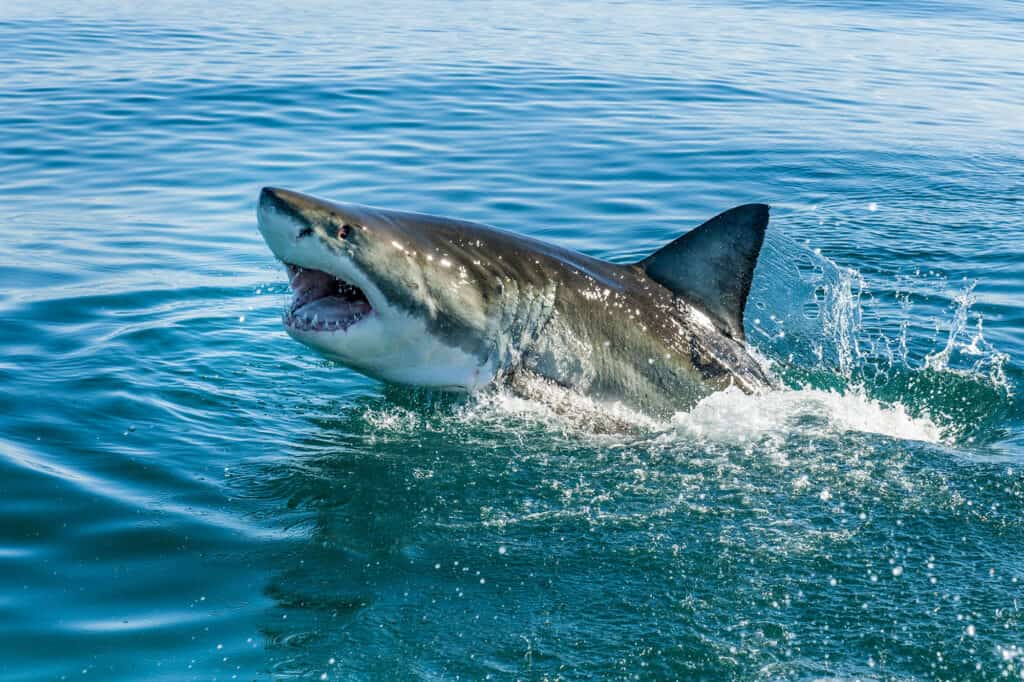California is the third largest state in the US. It has a diverse population of people and a diverse population of animals living in an ecosystem with deserts, mountains and oceans. Let’s look at some of the deadliest animals in California!
Deadly desert animals in California

iStock.com/Shoemcfly
There are three main deserts in California with the Mojave, Colorado/Sonoran and Great Basin covering parts of the state. Here you can expect dry, hot conditions throughout the year with little rainfall. You have probably heard of the driest spot in California which only gets about 1 ½ inches of rain a year…Death Valley. What kind of deadly animals live in Death Valley and other deserts in California?
- Mojave green rattlesnake: Compared to the western rattlesnake (another venomous snake in California) the Mojave green rattler has a green tint and is 2-4 feet long. They can be found in desert areas but are not aggressive and will keep to themselves if not provoked. According to the CDC, there are only an average of five deaths related to snake bites a year.
- Sidewinder rattlesnake: These snakes have a pinkish coloration and are named for their unique way of scooting across the terrain. They move in a sideways motion back and forth to get from point a to point b. They are venomous but are not known to be lethal.
- Bark Scorpion: The bark scorpion can be found in many southern states including the southeastern parts of California. They are the most venomous scorpions in the US. In other parts of the world, like Mexico for example, scorpions do have a history of fatalities, however in the US there have only been four recorded deaths in the last 11 years as of 2021.
- Brown recluse and black widow spider: The brown recluse is a small brown spider that packs a nasty bite. However, is rarely fatal, and the black widow is more venomous, but again rarely causing death in humans. According to the CDC there are an average of 7 spider related deaths per year, usually as a result of an allergic reaction to the venom.
Deadly mountain animals in California

fuyuna/Shutterstock.com
The two main mountain ranges in California are the Sierra Nevada on the eastern border of the state and the Coast Range which follows the coast. There are also the Cascade mountains in the northeastern part of the state. The highest peak in California is in the Sierra Nevada mountains, Mount Whitney, which has an elevation of 14,494 feet. Do animals even live at such high altitudes? Maybe not at the peak but throughout the Mount Whitney State Park they do have bears, marmots, deer, squirrels, mice and a few bird species. The park warns to be cautious of the bears and marmots…what is a marmot?
- Marmots: Marmots are large ground squirrels that can get to be 15lbs in weight. They are territorial but are not aggressive towards humans. However, if you encounter one you could be bitten by one of these rodents, causing an infection. Marmots also carry disease carrying ticks and fleas. So, avoiding marmots is the best precaution.
- Black Bear: Black bears are not just in the mountains in California. There are several healthy populations of them throughout the state. Again, they typically stay away from humans, but if you are camping in bear country be sure to keep you food in bear safe storage containers and store them away from your site. There are no records of black bear related fatalities in California.
Deadly marine animals in California

iStock.com/ELizabethHoffmann
The California coastline is 840 miles along the Pacific Ocean with hundreds of beaches along the shore. With vacationers and locals enjoying the waters, what dangerous animals should they be aware of? Marine mammals that live in the Pacific include sea lions, harbor seals, sea otters, elephant seals and a variety of whales including blue and humpback whales. Another favorite is dolphins which can be spotted all along the coast. What animals are the most dangerous for beach goers? Sharks and stingrays.
- Sharks: The great white shark is the most common threat off the coasts of California. They enjoy snacking on the seals and sea lions that frequent much of the coast, especially in southern California. Some beaches have a reputation for a higher number of shark attacks, like Surf Beach near Vandenberg Air Force Base, while other beaches have no record of shark attacks. According to the ISAF (International Shark Attack File) there were 129 shark-human interactions throughout the world in 2021 with 13 confirmed fatalities. That is a little higher than the average of 10 per year worldwide. Florida had the highest number of unprovoked attacks at 16 with zero fatalities and California came in third with four unprovoked attacks and zero fatalities. Surfers are still at the highest risk but when you look at the number of swimmers, surfers, water sports enthusiasts to the number of shark attacks and fatalities the risk of being bitten by a shark are extremely rare.
- Stingrays: Stingrays are round flat and gray with long thin tails with barbs. These tails can be used in defense. They strike a victim causing an initial injury and then inject venom into them. Off the California shores they typically burrow in the sand in shallow waters, so they are sharing the same space as many beach goers. According to a recent research survey, the average number of stingray bites a year is between 750-2000 in the US. There have only been 17 deaths recorded worldwide. However, one infamous case was that of Steve Irwin, the “Crocodile Hunter” who died off the coast of Australia when he was accidently stung by a stingray barb that went into his chest causing his death back in 2006. Steve was a conservationist that had several shows on Discovery Channel and also ran a wildlife park in Australia.
What about Killer Whales?
Killer whales (also known as orcas) are black and white marine mammals that are actually in the dolphin family. They are called killer whales because they can kill whales especially smaller baleen whales. However, their diets vary according to which type of killer whale. One type of North Pacific Ocean killer whale feeds mostly on salmon. Killer whales can hunt in pods of several orcas and have been videotaped working together to knock seals off an ice sheet. But would they do the same thing to an unsuspecting surfer? No, there are no recorded human fatalities due to killer whales in the wild. A couple fatalities have been reported by captive killer whales in marine parks, with one specific whale responsible for three separate deaths. So, unless you are a sea lion you are pretty safe from killer whales.
Up Next
- Deadliest Animals In Louisiana
- Deadliest Animals in Delaware
- The Top 10 Deadliest Animals In The World
The post Discover the Deadliest Animals in California appeared first on AZ Animals.
from Animal News, Facts, Rankings, and More! - AZ Animals https://ift.tt/alY0nWt